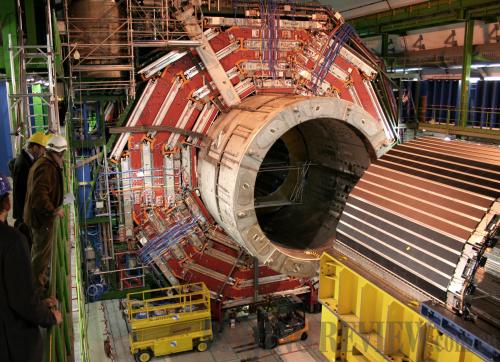|
 |
|
UNIQUE DEVICE: The Compact Muon Solenoid, or CMS, a detector of the Large Hadron Collider built in a 27 km-long tunnel under the Swiss-French border near Geneva, being installed in March 2007 (YANG JINGDE) |
Two beams of subatomic particles, called hadrons, either protons or lead ions, successfully collided at the record-high energy level of 7 trillion electron volts, inside the Large Hadron Collider (LHC), the world's largest and most powerful particle accelerator, on March 30, 2010, as part of an experiment aimed at uncovering the origins of the universe.
The LHC, a gigantic scientific instrument, lies in a 27 km-long tunnel under the Swiss-French border near Geneva. It is used by physicists to study the smallest particles—the fundamental building blocks of all things.
The experiments in the LHC marked the beginning of work that could lead to the discovery of fundamentally new principles in physics, said Chen Guoming, a researcher with the Institute of High Energy Physics (IHEP) of the Chinese Academy of Sciences (CAS), in an interview with Guangming Daily.
According to Chen, only 4 percent of matter in the universe is currently accounted for, and the other 96 percent, consisting of dark matter and dark energy, is still unknown to people.
"If the LHC can find the dark matter, it will arouse another revolution in science and usher in a new era of physics," Chen said.
He said the LHC has four detectors—Compact Muon Solenoid (CMS), A Toroidal LHC Apparatus (ATLAS), Large Hadron Collider beauty (LHCb) and A Large Ion Collider Experiment (ALICE ). Chinese scientists participated, along with over 40 countries, in the construction and experiments of all these detectors. By studying data that these unique particle detectors obtained during the high-energy proton collisions, scientists hope to find meaningful new physics.
This is one of the important international scientific projects that China has participated in, and Chen is the leader of the Chinese physicists in the CMS experiment.
He introduced that four institutes from China are working on the CMS experiment. Scientists from IHEP and Peking University have successfully built one third of the CMS' cathode strip chamber and resistive plate chamber and have joined in making the technical report. The Shanghai Institute of Ceramics under the CAS provided core detection materials to the CMS. The University of Science and Technology of China (USTC) participated in the research and production of the electromagnetic calorimeter. A CMS remote control center set up in IHEP is in charge of part of the real-time monitoring of the CMS experiment.
Jin Shan, another researcher with IHEP, works as the leader of the Chinese team for the ATLAS experiment. The team includes scientists from IHEP, USTC, Shandong University and Nanjing University.
"The aims of the CMS and ATLAS experiments are almost the same, and their experimental results can be cross-tested and verified," Jin said. Currently, he said, Chinese scientists in the CMS and ATLAS experiments are participating in the daily work of these two detectors' operation and the complicated analog data analysis.
Another important work that Chinese scientists are involved in is analyzing the LHC data. Chen Gang, Director of the Computing Center of IHEP, said the collisions in the LHC will produce numerous particles, which would be detected and recorded by detectors. Only after a complicated computing process, can scientists get an analyzed result of these data.
"The amount of computing is huge. It needs 100,000 CPUs to compute ceaselessly for a year," Chen said, "and this can not be finished by any country alone." Thus, he said, scientists from all over the world joined hands to establish a global computing platform.
The LHC project, with an investment of around $5.6 billion, was first launched on September 10, 2008, but suffered a serious malfunction nine days later. After more than a year of repairs, the LHC successfully recommenced operation in November 2009.
After the successful collisions on March 30, 2010, the European Organization for Nuclear Research (CERN) will continue to run the LHC for 18 to 24 months with the objective of delivering enough data from the experiments to make significant advances across a wide range of physics areas, said Rolf-Dieter Heuer, Director General of CERN. After that, the LHC will be shut down for maintenance for up to a year. When it reopens, it will attempt to create 14 trillion electron volts events, he said. |
